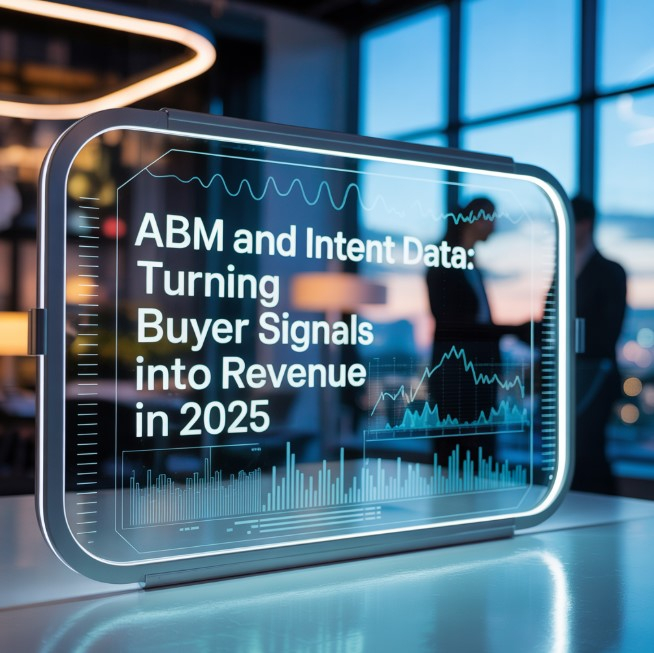Introduction
In 2025, B2B buyers leave behind a rich digital footprint long before they engage with a sales rep. From research on competitor websites to engagement with industry content, these behaviors—known as intent data—are invaluable for Account-Based Marketing (ABM) strategies.
When integrated into ABM campaigns, intent data helps marketing and sales teams pinpoint which accounts are actively in-market, personalize outreach at scale, and accelerate revenue generation. Simply put, ABM powered by intent data transforms blind outreach into data-driven precision marketing.
This blog explores why intent data is critical to ABM success, the challenges organizations face, proven strategies to leverage buyer signals, and the future of intent-driven account engagement in 2025.
What is Intent Data and Why It Matters for ABM
Intent data refers to signals that indicate a prospect’s buying interest. These signals can come from:
- First-party data (website visits, content downloads, webinar attendance)
- Third-party data (research activity across external websites, content syndication networks, industry publications)
- Technographic and firmographic insights (tech stack usage, company size, and growth stage)
In the ABM context, intent data empowers marketers to:
- Identify high-intent accounts earlier in the buying journey
- Map outreach to active pain points and research topics
- Prioritize resources on accounts most likely to convert
- Deliver hyper-personalized content at the right time
📊 Stat: Demand Gen Report found that companies using intent data in ABM see 2.5x higher engagement rates compared to those that don’t.
Challenges in Using Intent Data for ABM
- Data Overload
- Marketers often struggle with too many signals from multiple vendors, making it hard to identify the most relevant ones.
- Accuracy & Validation
- Not all intent signals mean a buyer is ready. Misinterpreting data can waste resources on false positives.
- Sales-Marketing Misalignment
- Without clear workflows, sales teams may not act on insights, leading to missed opportunities.
- Integration Complexity
- Incorporating intent data into CRM, ABM platforms, and marketing automation tools requires strong data orchestration.
- Privacy Concerns
- With stricter privacy laws in 2025, intent data usage must comply with GDPR, CCPA, and regional regulations.
Proven Strategies to Leverage Intent Data in ABM
- Prioritize High-Intent Accounts
- Use predictive scoring models to rank accounts showing sustained research activity across buying topics.
- Align Intent Data with Buyer Personas
- Map signals to specific personas within accounts (e.g., IT decision-makers, CMOs, CFOs) to tailor content precisely.
- Activate Multi-Channel Engagement
- Deliver targeted ads, personalized emails, and LinkedIn outreach triggered by intent signals.
- Feed Insights into Sales Playbooks
- Provide sales teams with real-time insights (e.g., “This account is researching ABM platforms”) to guide outreach.
- Integrate with ABM Tech Stack
- Connect intent platforms like Bombora, 6sense, or Demandbase with your CRM and ABM systems for unified workflows.
Trends and the Future of Intent-Driven ABM in 2025
- Real-Time Intent Activation: AI-driven platforms will trigger immediate engagement when accounts show fresh intent signals.
- Deeper Personalization: Content will be dynamically adjusted based on the exact keywords and research behaviors of buyers.
- Account Journey Mapping: Intent data will be integrated into journey analytics to predict when accounts are about to enter RFP stages.
- Cross-Channel Orchestration: Marketers will use intent signals to sync ads, emails, webinars, and sales calls for unified experiences.
- Revenue Attribution with Intent: ABM leaders will tie intent signals directly to closed-won deals, strengthening ROI measurement.
Pro Tips & Bonus Insights
- Don’t treat all signals equally—focus on recency, frequency, and relevance of activity.
- Combine first-party and third-party intent data for a complete picture of account behavior.
- Use intent-driven content hubs where accounts can explore tailored resources aligned to their active research.
Conclusion
In 2025, intent data is the fuel that powers ABM precision. By translating buyer signals into targeted engagement, B2B marketers can shorten sales cycles, increase win rates, and focus resources on the accounts that matter most.
The future of ABM belongs to companies that combine intent-driven insights with personalization at scale—transforming raw data into predictable revenue growth.
